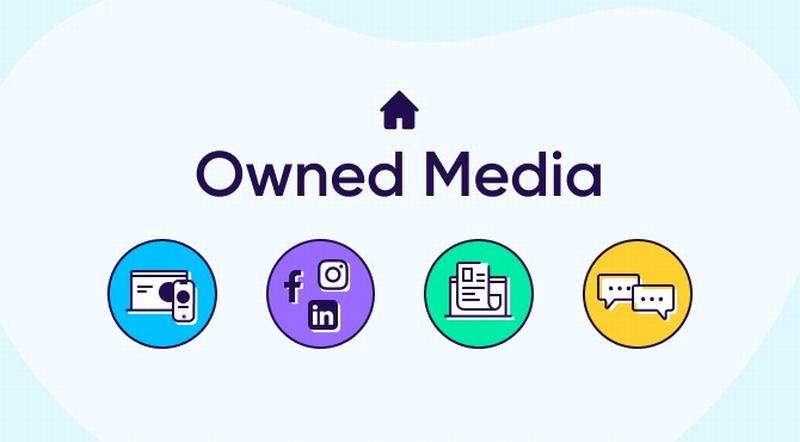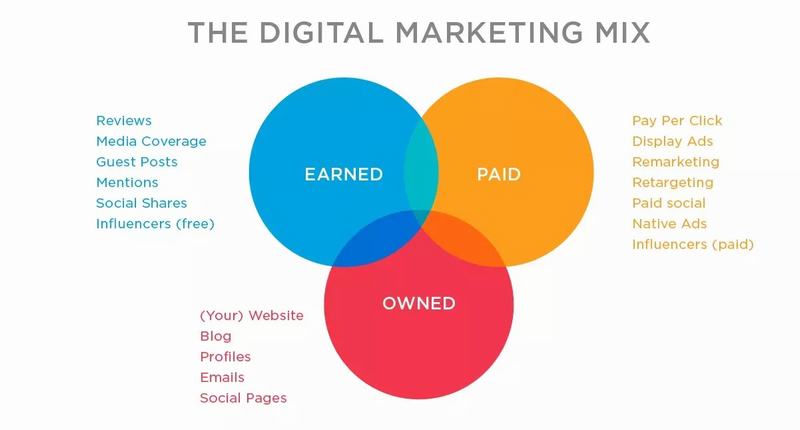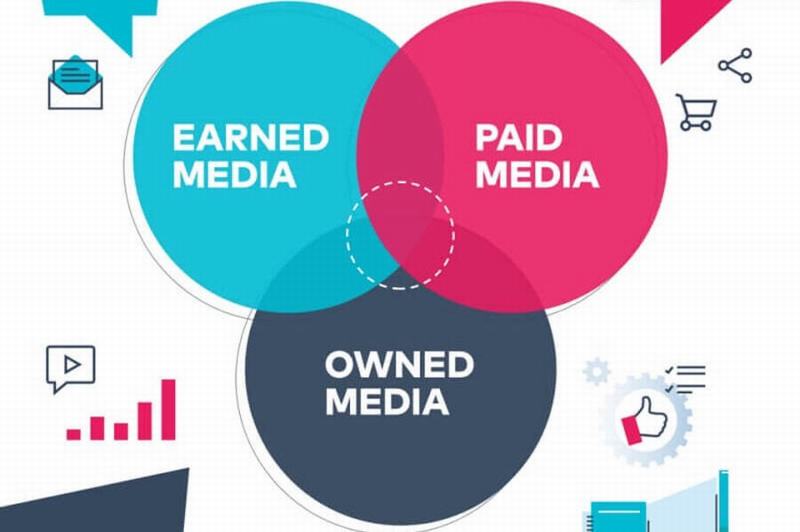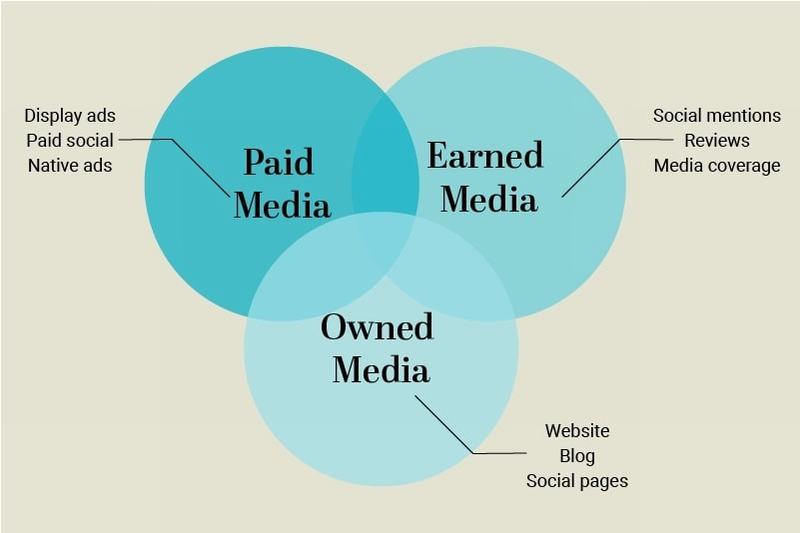We will explore examples of Owned media such as websites, blogs, Social Media pages, and Email marketing, and understand how to use Owned media to build brands, engage with customers, and increase Advertising effectiveness. In this article, we will learn about what Owned media is, its role in advertising and marketing, and the differences between Owned media, Earned media, and Paid media.
In Digital Marketing, Owned media is one of the effective media that helps businesses affirm Brand reputation and build trust from customers.
Owned Media are all online assets that are owned and controlled by a brand, such as a blog, website, or social media channels. The more media channels a business owns, the larger its footprint, which means more potential to reach customers and followers.
With Owned Media you have complete control over creating, designing and formatting Content as you wish and posting whatever you think will be most appealing to your audience.

Owned media is also known as owned media channels.
Owned Media plays an important role in a business’s marketing strategy, especially in the digital age, for the following reasons:
Complete control
With Owned media, businesses have the freedom to create and publish content that aligns with their brand goals and values without being dependent on any regulations or algorithms from external platforms.
Cost optimization
Compared to paid media channels such as advertising, Owned Media has lower operating costs but brings long-term effectiveness. Deploying Owned Media with a suitable content strategy and SEO optimization, you can achieve natural traffic without Investing too much money in advertising.
Establish long-term relationships with customers
Owned Media creates a direct communication channel between businesses and customers, providing valuable content that is useful to them. From there, promote interaction and build strong relationships.

Owned media channels help businesses build long-term relationships with customers.
Owned media plays a vital role in optimizing your website for SEO. If your content is targeted to a specific audience segment, has an attractive headline, incorporates targeted keywords, and has unique images, search engines will notice your content. This will help your content rank higher in search engines.
Aggregate and analyze customer data
Owned Media helps businesses collect data and analyze customer behavior and preferences accurately. From there, personalize experiences and optimize marketing strategies.
Flexible in content adjustment
Owned Media allows businesses to quickly update content according to the latest trends, meeting customer needs and interests in a timely manner.
Businesses can easily test different content formats, headlines, and calls to action to optimize performance and find the approach that best resonates with their target audience.
Some popular types of Owned Media today:
Website
Website is one of the most typical Owned Media. Here, businesses have the freedom to present information about their products, services and core values. The website is also a platform to implement marketing campaigns, collect data and analyze user behavior.
If you optimize SEO factors well, your website will also help improve its search position on SERP search engines.
Blog
Blogs are often places to provide long articles for readers to better understand the business’s industry. Blog content is always optimized for search engines, thereby helping businesses build prestige and position in the industry, attracting customers with Creative and attractive content.
Email Marketing
Email marketing is a popular media that allows businesses to send messages directly to customers’ inboxes. With Email, you can update customers with information about promotions, new product introductions, etc.
But to use this medium effectively, you need to create engaging, personalized emails to maintain customer relationships and motivate them to take action.
Video Marketing
Video marketing is a form of media that uses videos to promote a business’s products or services. YouTube can be considered an example of this form of Owned Media. Additionally, you can also publish videos on your website and other channels.
Creating great videos with concise, engaging content that helps people understand how to use your products and get to know your brand is essential. Short-form videos are all the rage these days.
Social Network
Social networks such as Facebook, Instagram, etc. are communication platforms that allow businesses to interact with customers quickly and effectively. Through social networks, you can share videos, images, run advertising campaigns to increase brand awareness and connect more with customers.

Step 1: Determine strategic communication goals
To implement an effective Owned Media strategy, you need to define your communication goals from the beginning. This goal can be to increase brand presence, attract customers, increase conversion rates, or establish and maintain customer relationships, etc. You need to set specific, feasible goals, with a certain deadline and within a measurable scope.
For example, the goal for this Owned Media strategy is to increase brand awareness by 20% in 6 months, attract 1,000 leads per month, or increase website conversion rate by 15%.
Step 2: Choose the appropriate Owned Media channel
To choose an Owned Media channel, you need to clearly understand the target customer profile to choose the right channel, which can be: website, blog, social network, Mobile application, email marketing, etc. In addition, this choice must also be based on the budget and requirements of the brand. To optimize efficiency at the highest level, you can combine multiple channels together.
For example, use blogging to attract leads, social media to build community, and email marketing to nurture leads.

Choose Owned Media.
Step 3: Find high-quality content ideas
Owned Media content must be engaging, valuable and relevant to the target audience. At the same time, it must reflect the brand’s core message and values. Content should be presented in many different forms such as articles, images, videos, infographics, webinars, podcasts, etc. to suit the interests and choices of each target group.
Step 4: Increase interaction to attract customers
To attract customers to interact on Owned Media channels, we encourage you to use other forms of organizing events, surveys, comments, and sharing. Through these activities, businesses will be able to understand user behavior, expand brand influence, and connect with new customers.
Step 5: Evaluate strategic performance
Evaluate strategy performance using traffic, conversion, engagement, and ROI analytics tools. Based on these results, you will make flexible strategy adjustments based on the collected data. Continuously optimize your Owned Media strategy for best results.
Here are some examples of successful Owned Media implementation:
Case study: Nike
Target: Personalize the experience, build a loyal community with Nike
Strategy: Nike leverages its website and mobile apps to deliver personalized experiences to users, focusing on two standout apps:
- Nike+ Run Club: Provides running training guidance, tracks progress, and encourages users to reach their goals.
- Nike Training Club: Provides diverse workout guidance, progress tracking, and encourages users to achieve their fitness goals.
Result: This strategy pays huge dividends:
- The app helps users connect with Nike and stay motivated to work out.
- Millions of users log in every day, creating a community that engages and loves the brand.
- Nike affirms its position not only through products but also through the experience and value it brings to users.
Case Study: Coca Cola
Strategy: Coca Cola has made the most of Owned Media for the “Share a Coke” campaign. The campaign content is as follows:
- Replace traditional logos on packaging with 250 popular names – creative ideas that spark interest and attract attention.
- Encourage people to share drinks with friends and family, spreading the message of connection and community engagement.
- Create custom websites for customers to freely create their own bottle labels.
Result: The campaign created a strong ripple effect:
- The wave of interaction exploded on social networks as millions of photos and posts were shared around the world.
- Enhance brand recognition to attract attention and create a strong memory in the customer’s mind.
- The campaign contributes to effective sales promotion.
| Owned media | Earned media | Paid media | |
| Target | A media channel where the brand has full control over the content posted without having to pay fees or be subject to any regulations. | Traditional channels encourage customers to discuss and respond to a business’s brand and products in a natural way. | Media channels that brands pay to advertise on to reach their desired target audience. |
| Promotional activities | Fanpage Facebook page, Instagram page, website, brand app,… | Customer reviews, comments, and shares from customers on articles in newspapers, social networks, etc. |
|
| Advantage |
|
|
|
| Limit |
|
|
|
Above is all the information about Owned Media that we have gathered for you. Hopefully, the knowledge we provide will help you in your future journey.
Comment Policy: We truly value your comments and appreciate the time you take to share your thoughts and feedback with us.
Note: Comments that are identified as spam or purely promotional will be removed.
To enhance your commenting experience, consider creating a Gravatar account. By adding an avatar and using the same e-mail here, your comments will feature a unique and recognizable avatar, making it easier for other members to identify you.
Please use a valid e-mail address so you can receive notifications when your comments receive replies.